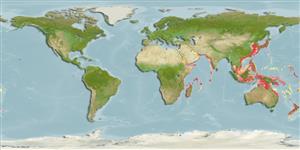Environment: milieu / climate zone / depth range / distribution range
Ekologi
marina bottenlevande; djupintervall 46 - 100 m (Ref. 11441). Tropical; 42°N - 22°S, 55°E - 141°E
Indo-West Pacific: Funka Bay of Hokkaido to the South China Sea and farther south (Ref. 559). Recorded from Oman (Ref. 11441).
Length at first maturity / Size / Vikt / Age
Maturity: Lm 6.8, range 7 - 7 cm
Max length : 14.8 cm TL hane/ej könsbestämd; (Ref. 125279); publicerad maxvikt: 15.20 g (Ref. 112063)
Taggstrålar i ryggfenan (totalt): 8; Mjukstrålar i ryggfenan (totalt): 9; Taggstrålar i analfenan 2; Mjukstrålar i analfenan: 8. Ten to 12 brown bands on sides of body. Number and width of these bands varies with habitat. Body shape and coloration closely resembles A. ellioti, but distinguished by not having luminous organ. Attains 8 cm TL.
Abundant on sandy and muddy bottoms from coastal inlets to deeper waters (Also Ref. 11230). Breeding season is from July to September. Males brood eggs in the mouth. Made into fish paste (Ref. 559 and 637).
Mouthbrooders (Ref. 240). Distinct pairing during courtship and spawning (Ref. 205).
Masuda, H., K. Amaoka, C. Araga, T. Uyeno and T. Yoshino, 1984. The fishes of the Japanese Archipelago. Vol. 1. Tokai University Press, Tokyo, Japan. 437 p. (text). (Ref. 559)
IUCN Red List Status (Ref. 130435)
Threat to humans
Harmless
Human uses
Ytterligare information
referenserVattenbrukVattenbruksprofilAvelslinjerGenetikElectrophoresesÄrftlighetSjukdomarBehandlingNutrientsMass conversion
MedarbetareBilderStamps, Coins Misc.LjudCiguateraHastighetSimsättGälytaOtolithsHjärnstorlekSyn
Verktyg
Special reports
Download XML
Internet-källor
Estimates based on models
Preferred temperature (Ref.
123201): 17.3 - 28.1, mean 26.4 °C (based on 345 cells).
Phylogenetic diversity index (Ref.
82804): PD
50 = 0.5000 [Uniqueness, from 0.5 = low to 2.0 = high].
Bayesian length-weight: a=0.01413 (0.00837 - 0.02384), b=3.18 (3.03 - 3.33), in cm total length, based on LWR estimates for this species & (Sub)family-body (Ref.
93245).
Trofisk nivå (Ref.
69278): 3.7 ±0.5 se; based on diet studies.
Resiliens (Ref.
120179): Hög, lägsta populationsfördubblingstid mindre än 15 månader (tm=1; K=0.37-1.12; Tmax=3-5).
Fishing Vulnerability (Ref.
59153): Low vulnerability (12 of 100).
